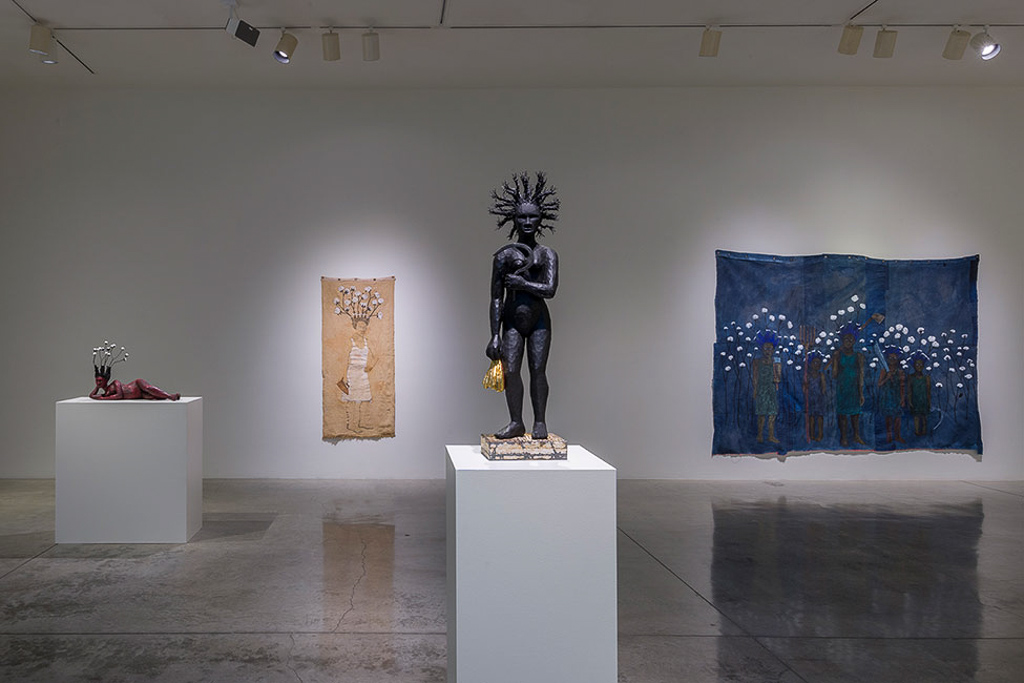Topsy Transmuted
Words by Marc Haefele, Senior Arts Writer, Bermudez Projects
“Oh Lord, Miss Eva, I is tryin’!” said Topsy, wiping the tears from her eyes. “But Lor’ it is so hard to be good! `Pears like I ain‘t used to it, no ways.”
“Jesus knows it, Topsy; he is very sorry for you; He will help you.’’
– “Uncle Tom’s Cabin,” by Harriet Beecher Stowe
Since her first appearance in the 19th century’s most popular novel, the character of Topsy, the rebellious orphan slave girl, has baffled serious readers. Is she, as the author seems to say, simply a hopeless delinquent, redeemed by the death of the saintly little Eva? Or is she something more serious, less shameful: an unwitting but total revolutionary against the vicious “peculiar institution” of slavery?
Alison Saar, whose 2016 LA Louver show gave us a racially inflected panorama of the 1927 Great Mississippi Flood, has narrowed her focus with her latest assembly of work, Topsy Turvy. Most of Saar’s visions of Topsy, refused all “goodness,” all redemption – even Jesus. And in the show, Topsy was divided into 16 representations, variously of her revolt and of her repression. Each of them had its own power and significance.
The key symbol of repression is cotton, the South’s great money crop, the soft white fiber whose cultivation enslaved millions. In Stowe’s book, Topsy’s hair is “braided in sundry little tails that stuck out in every direction.” In Saar’s work, the girl’s hair incarnates her submission: when it isn’t bound up in white cotton ribbons, it sprouts its own cotton bolls. The cotton plants are rooted in her body, in her existence. In one of Saar’s most vivid depictions, Jubilee, a small wooden Topsy shears off her own wiry locks, as if to liberate herself from them and the servitude they represent. But in another, The Wrath of Topsy, the braids themselves represent offensive power: like the snakes radiating out from the Medusa’s head.
Another power of Topsy, only hinted at in the book, is seduction: A naked Topsy reclines in a ripe, midnight cotton patch, evoking the erotic savagery of dark nature, like a jungle study of Henri Rousseau. It recalls the repressive aspects of slave sexuality.
The most militant portion of the show was a series of five, just-under-life-size statues of Topsy, each wielding a tool of her agricultural submission in a gesture of overt aggression: a bale hook for cotton; a machete for sugar cane; a hoe for indigo; a sickle for rice and a tobacco knife. Now, the figures’ cotton-boll headdresses suggest camouflage for a night raid on the plantation house. Together, the five have the martial presence of those life-size ceramic warriors from an ancient Chinese tomb.
The largest, one wants to say the grandest Topsy piece (it also exists as a study) is called White Guise. Over 6 and a half feet tall, it represents another possible future for the scapegrace teen-age Topsy. A Topsy who responded to Eva’s dying command to shape up, a Topsy who, as it were, found Jesus.
What’s she’s become here is a house negro. Instead of wielding a sickle or a hoe she’s holding an iron. Instead of a field-hand’s rags, she wears a neat white dress, (fashioned from Victorian-era ceiling tin), complete with flowery embossed décor. This was the optimal Topsy, the best she could be as a slave. A permanent servant.
In many ways, this was the cruelest depiction of them all. Clearly, Saar saw that Topsy is at her inspiring best in insurrection. It is a lesson for us all.
All images courtesy of Alison Saar and LA Louver. © 2018. All rights reserved.





